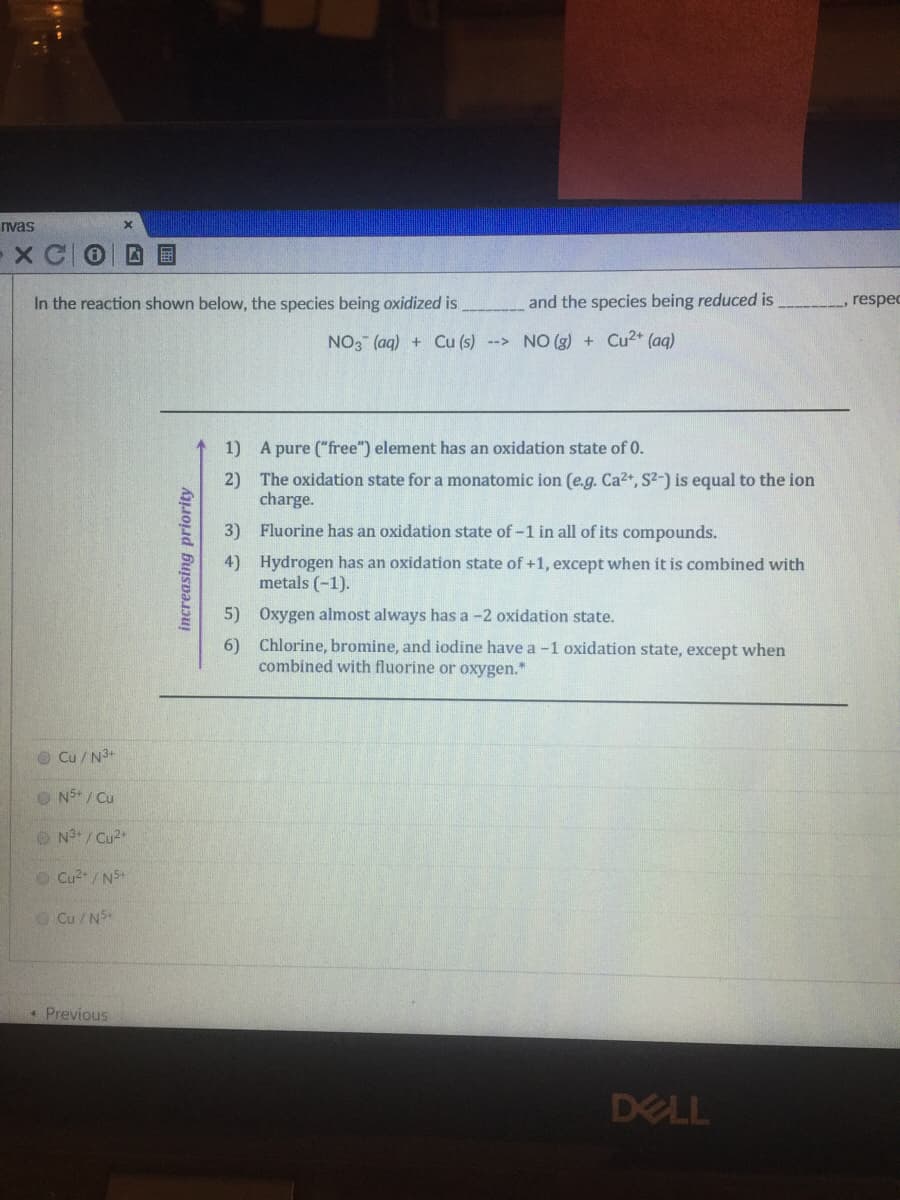Chemistry: Principles and Reactions
8th Edition
ISBN:9781305079373
Author:William L. Masterton, Cecile N. Hurley
Publisher:William L. Masterton, Cecile N. Hurley
Chapter4: Reactions In Aqueous Solution
Section: Chapter Questions
Problem 74QAP: A solution contains both iron(II) and iron(III) ions. A sample Of the solution is titrated with 35.0...
Related questions
Question

Transcribed Image Text:nvas
In the reaction shown below, the species being oxidized is
and the species being reduced is
respec
NO3 (aq) + Cu (s) --> NO (g) + Cu2+ (aq)
1) A pure ("free") element has an oxidation state of 0.
2) The oxidation state for a monatomic ion (e.g. Ca2+, S2-) is equal to the ion
charge.
3) Fluorine has an oxidation state of -1 in all of its compounds.
4) Hydrogen has an oxidation state of +1, except when it is combined with
metals (-1).
5) Oxygen almost always has a -2 oxidation state.
6) Chlorine, bromine, and iodine have a -1 oxidation state, except when
combined with fluorine or oxygen."
O Cu / N3+
O N5+ / Cu
O N°/ Cu2+
O Cu2/N5+
O Cu / NS
*Previous
DELL
国
increasing priority
Expert Solution
This question has been solved!
Explore an expertly crafted, step-by-step solution for a thorough understanding of key concepts.
This is a popular solution!
Trending now
This is a popular solution!
Step by step
Solved in 2 steps with 1 images

Knowledge Booster
Learn more about
Need a deep-dive on the concept behind this application? Look no further. Learn more about this topic, chemistry and related others by exploring similar questions and additional content below.Recommended textbooks for you

Chemistry: Principles and Reactions
Chemistry
ISBN:
9781305079373
Author:
William L. Masterton, Cecile N. Hurley
Publisher:
Cengage Learning

Principles of Modern Chemistry
Chemistry
ISBN:
9781305079113
Author:
David W. Oxtoby, H. Pat Gillis, Laurie J. Butler
Publisher:
Cengage Learning


Chemistry: Principles and Reactions
Chemistry
ISBN:
9781305079373
Author:
William L. Masterton, Cecile N. Hurley
Publisher:
Cengage Learning

Principles of Modern Chemistry
Chemistry
ISBN:
9781305079113
Author:
David W. Oxtoby, H. Pat Gillis, Laurie J. Butler
Publisher:
Cengage Learning


Chemistry: Principles and Practice
Chemistry
ISBN:
9780534420123
Author:
Daniel L. Reger, Scott R. Goode, David W. Ball, Edward Mercer
Publisher:
Cengage Learning


Chemistry: An Atoms First Approach
Chemistry
ISBN:
9781305079243
Author:
Steven S. Zumdahl, Susan A. Zumdahl
Publisher:
Cengage Learning